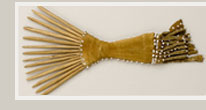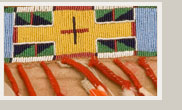| Household and family groups formed the foundation of Nimiipuu social organization. Men, women, and children all had defined roles. Families lived and worked together and formed social alliances.
When the Lewis and Clark expedition enountered the Nimiipuu in 1805, the two Captains observed independent villages along rivers and streams. Each village was governed by a council that chose and advised a headman. Local villages were, in turn, organized into a band that was represented by a band council composed of individuals of the various villages that had elected a headman. In the same way, neighboring bands were organized into composite bands that shared a common background as well as blood and marital ties. While unit was important, each village and band was autonomous.
Men were responsible for the welfare of their families. They hunted and fished to provide sustenance for the family. They made the tools required for these tasks and passed on these skills to their sons. Game was available year round. However, it was fishing that consumed men’s time during the annual migration of salmon from the sea to the rivers of the interior northwest. Fish was critical to sustaining the Nimiipuu and the Columbia River basin was once one of the richest migratory salmon habitats in the world. Salmon and other fish provide more than food, they represent what mother earth can provide.
Women ran the household and took care of infants and the younger children. They used their extensive botanical knowledge to collect the abundant edible and medicinal plants found in region. Children helped by gathering roots and berries that provided about 25% of the food supply.
MORE...
|








_Bonnet.jpg)
_Headdress.jpg)




_Shirt.jpg)
_Shirt.jpg)











